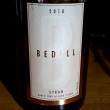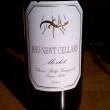A Surprising Second Label at Shaw Vineyard
By Jason Feulner, Finger Lakes Correspondent
(Note: this story is part one of a two-part series highlighting some unique production choices at Shaw Vineyard.)
 Wineries that produce a second label do so for many reasons, although the secondary nature of the label almost assuredly implies less-expensive, less-focused wine.
Wineries that produce a second label do so for many reasons, although the secondary nature of the label almost assuredly implies less-expensive, less-focused wine.
Some top-flight establishments offer a second label that is still a solid wine by almost any standard, although many wineries throw whatever they can into a bottle and call it a day, often not focusing on quality in the process.
On a recent tasting at Shaw Vineyard I encountered this pinot grigio, a part of their second-label line, Li Bella. The bright blue bottle and watercolor dragon fly were certainly attractive but I did not necessarily expect that the wine would stand up to the other wines under the main Shaw label.
I was wrong.
While the pinot grigio has just a touch of sweetness (1.4 RS), it is also a crisp, focused, aromatic white that exhibited a great deal of quality and depth. In fact, it was simply a good Finger Lakes white wine-period.
I inquired about the origin of the label from owner and winemaker Steve Shaw. The original idea, conceived by Steve's son and marketing partner, Steve Shaw Jr., was to produce a fresher, brighter style for consumption by a target market of female wine drinkers in New York City and Florida. "It's done very well downstate," Steve Shaw Jr. explains. "The wine is at a very competitive price point for the market."
The label itself was designed and painted by Steve Shaw Jr.
Although the wine's image was softened for marketing purposes, no major compromises were made in the production of the wine. "This wine was made like all Shaw Vineyard wines," emphasizes Steve Shaw Sr. "I used only whole cluster press, with no crushing and no pump-over, which is the case for all my wines. The only difference is the RS, which I would keep around .8 if this was under the Shaw label."
Currently, Shaw does not make a pinot grigio for his main line.
400 cases of Li Bella were made for the 2007 vintage, which sold out quickly. 600 cases were made for 2008. The grapes were sourced from a per acre contract and will be completely single vineyard for the 2009 vintage.
Due to the success of the Li Bella experiment, Shaw Vineyard will also produce a 2009 cabernet franc for the same line. While many entry-level reds are produced and bottled in the same year, Shaw is adamant that the difference in quality between the main label cabernent fanc and the Li Bella version will be minimal. "At this point, I'm planning on aging the Li Bella for 18-24 months instead of my typical 34 months for a red."
Perhaps my expectations are low for a second label, but in the case of Shaw and Li Bella I was pleasantly surprised by the focus on quality across the spectrum. As it stands, Li Bella is more of an alternative label than a secondary one, which at a few bucks less is a great deal for the consumer.















Jason - I’m curious about the move to Cabernet Franc. Pinot Grigio is, after all, an easy-selling and well known wine. Cabernet Franc is sort of the antithesis of that. It would be wonderful to see the Cab Franc sell just as briskly, but that might be a stretch…
Nice piece. Steve Shaw is always a fun person to chat with, have a drink with, etc. Passionate and opinionated — hard to beat that.
Why make a 1.4% RS wine if it would be balanced at .8% RS?
I’m sure the answer has less to do with wine making and more to do with marketing and sales, but I do see wineries cynically over sweetening up here in Niagara too.
I think they are under-estimating their customers ability to enjoy a balanced wine.
To put the RS into context of the conversation I had with the winemaker, I don’t think the 1.4 RS was created as a cynical marketing ploy as it works very well with this wine as bottled. All the other wines at Shaw are very dry. Since 1.4 is not extremely high at all, I took away from the interaction that this varietal and its grapes lent itself to this marketing experiment with just a touch more RS.
I’m not a winemaker, but it seems that .8 to 1.4 is not a huge swing at all and comes down to nuance and style more than a defiance of balance. At some wineries that bottle different versions of certain varietals, ranging from under 1 to nearly 4…well, that is a marketing ploy indeed!
As for the cab franc inquiry, your guess is as good as mine. Since the overall goal is quality cab franc, it will be interesting to see if pricing, marketing, packaging, etc. have an effect that would otherwise be hard to predict.
Bryan,
It is gospel for most places that +RS = +SALES.
When I talk about marketing, I try not to insinuate that it has to be a “ploy”, but rather a strategic business decision. So I don’t think of it as a negative.
cool piece, ive been trying to talk my bosses into doing a second lable, i think it would help buisness.
Bryan, talk about cynical? A: i think you underestimate a wines ability to be ballanced and have sweetness, and B: no amount of dissaproving browbeating is going to convince the majority of people in the world that dry wine is better than sweet. wineries are tourist driven buisness, and sweet sells, period.
Rowland,
I don’t intend to speak for Bryan, but he implies an interesting question through a previous comment: Is there a single balance point for wines with regards to sugar and acidity? More specifically, if a winemaker decides that a wine is balanced at 0.8 RS, can that same wine still be balanced at 1.4? Or is it technically off balance and favoring sugar a little too much?
Or is there a range of balance in wine? We talk about Rieslings showing impressive balance at 2.5, but that same producer might also have a Dry Riesling that clocks in at 0.5 — which we might also say is “balanced.” Is that technically possible?
(I think it is, but it’s an interesting discussion).